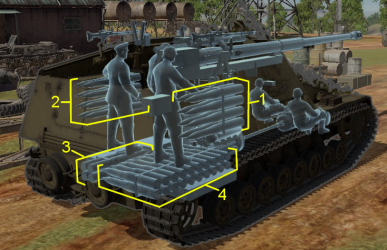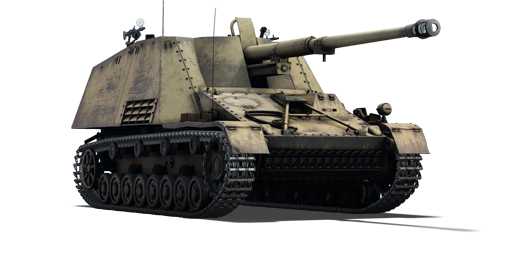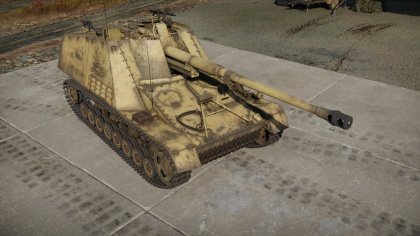Nashorn
Contents
Description
The 8,8 Pak 43/1 Sf."Nashorn" (Rhinoceros) is a rank III German tank destroyer
with a battle rating of 5.3 (AB/RB/SB). It was introduced in Update 1.57 "Battle March". It was developed as an interim solution to deal with Soviet heavy tanks on the Eastern front who were immune to the guns of Marders. It consists of an 88 mm anti-tank gun PaK 43 mounted on a Panzer IV chassis. It is also known as the Hornet (Hornisse in German).
General info
Survivability and armour
Armour type:
- Rolled homogeneous armour (hull, gun shield, superstructure)
- Structural steel (gun breech, mudguards)
| Armour | Front (Slope angle) | Sides | Rear | Roof |
|---|---|---|---|---|
| Hull | 15 mm (72°) Front glacis 30 mm (27°) Driver port - front 30 mm (21°) Lower glacis 20 mm (21°) Add-on tracks over lower glacis |
20 mm 10 mm (33°) Driver port - side |
20 mm (10°) 15 mm (9°) Add-on wheels |
15 mm (18°) Front glacis from above |
| Superstructure | 15 mm (28°) Conical gun shield 10 mm (35°) Outer panels 10 mm (41°) Inner panels connecting with the gun shield |
10 mm (15°) | 10 mm (13°) | N/A |
Notes:
- Suspension wheels and torsion bars are 15 mm thick while tracks are 20 mm thick.
- The bottom of the hull is 15 mm thick and mudguards are 4 mm thick.
The Nashorn's armour is paper-thin; it will not protect the crew or internal modules even from heavy-calibre machine gun fire. And, the vehicle can be hull-broken by high-calibre HE rounds.
The Nashorn also lacks roof protection, making it a very desirable target for enemy fighters and attackers. Stay behind cover to avoid strafing runs or rocket attacks.
One interesting (and somewhat comical) note on the Nashorn's armour is that being so thin, high-penetration shells may pass through it without detonating at all.
Mobility
| Game Mode | Max Speed (km/h) | Weight (tons) | Engine power (horsepower) | Power-to-weight ratio (hp/ton) | |||
|---|---|---|---|---|---|---|---|
| Forward | Reverse | Stock | Upgraded | Stock | Upgraded | ||
| Arcade | 44 | 9 | 24.3 | 426 | 572 | 17.53 | 23.54 |
| Realistic | 40 | 8 | 265 | 300 | 10.91 | 12.35 | |
Armaments
Main armament
| 88 mm PaK 43 | Turret rotation speed (°/s) | Reloading rate (seconds) | |||||||||||
|---|---|---|---|---|---|---|---|---|---|---|---|---|---|
| Mode | Capacity | Vertical | Horizontal | Stabilizer | Stock | Upgraded | Full | Expert | Aced | Stock | Full | Expert | Aced |
| Arcade | 40 | -5°/+20° | ±15° | N/A | 10.6 | 14.6 | __.__ | __.__ | 20.9 | 8.7 | _.__ | _.__ | 6.7 |
| Realistic | 7.1 | 8.4 | __.__ | __.__ | 12.0 | ||||||||
The 88 mm PaK 43 gun has great penetration statistics at all ranges and angles with an average reload time. Due to the vehicle's design, the gun should be used to snipe enemy targets from long ranges. Most enemy tanks will be crippled or destroyed if a shot connects.
Ammunition
The available ammunition allows for engaging all types of targets:
- PzGr 39/43: APCBC; an armour-piercing shell with a high penetration power and an explosive filler that will destroy any tank that is penetrates.
- PzGr 40/43: APCR; a composite round with the best penetration but no explosive filler and will only penetrate flat vertical surfaces.
- Hl.Gr 39: HEAT; a shaped charge with average penetration but without penetration loss over distance. Only penetrates flat vertical surfaces but the post-penetration damage is very effective on open and lightly armoured vehicles. Very slow shell travelling at circa half the speed of your fastest projectiles.
- Sprgr.43: HE; useful for destroying aircraft and lightly armoured vehicles. Slow shell travelling at circa 3/4 of the speed of your fastest projectiles.
| Penetration statistics | |||||||
|---|---|---|---|---|---|---|---|
| Ammunition | Type of warhead |
Penetration @ 0° Angle of Attack (mm) | |||||
| 10 m | 100 m | 500 m | 1,000 m | 1,500 m | 2,000 m | ||
| PzGr 39/43 | APCBC | 237 | 234 | 222 | 207 | 194 | 181 |
| PzGr 40/43 | APCR | 279 | 273 | 252 | 227 | 205 | 185 |
| Hl.Gr 39 | HEAT | 110 | 110 | 110 | 110 | 110 | 110 |
| Sprgr.43 | HE | 14 | 14 | 14 | 14 | 14 | 14 |
| Shell details | |||||||||
|---|---|---|---|---|---|---|---|---|---|
| Ammunition | Type of warhead |
Velocity (m/s) |
Projectile Mass (kg) |
Fuse delay (m) |
Fuse sensitivity (mm) |
Explosive Mass (TNT equivalent) (g) |
Ricochet | ||
| 0% | 50% | 100% | |||||||
| PzGr 39/43 | APCBC | 1000 | 10.2 | 1.2 | 14 | 108.8 | 48° | 63° | 71° |
| PzGr 40/43 | APCR | 1130 | 7.3 | N/A | N/A | N/A | 66° | 70° | 72° |
| Hl.Gr 39 | HEAT | 600 | 7.6 | N/A | 0.3 | 1,100 | 62° | 69° | 73° |
| Sprgr.43 | HE | 820 | 9.4 | 0.1 | 0.5 | 1,000 | 79° | 80° | 81° |
Ammo racks

| Full ammo |
1st rack empty |
2nd rack empty |
3rd rack empty |
4th rack empty |
Visual discrepancy |
|---|---|---|---|---|---|
| 40 | 33 (+7) | 25 (+15) | 21 (+19) | 1 (+39) | No |
Notes:
- To go into battle with the flanks empty of ammo, pack 25 (+15) shells (racks 1 and 2 empty).
- Racks disappear after you've fired all shells in the rack.
Machine guns
| 7.92 mm MG34 | ||||
|---|---|---|---|---|
| Mount | Capacity (Belt) | Fire rate | Vertical | Horizontal |
| Pintle - left side | 2500 (150) | 900 | -5°/+15° | -125°/-5° |
| Pintle - right side | 2500 (150) | 900 | -5°/+15° | +5°/+120° |
The Nashorn has two MG34 (7.92 mm) machine guns covering the vehicle's flanks. Since they are secondary weapons, there are no ammunition belt options. Furthermore, they have various blind spots (e.g. the rear and the front of the tank and the area above the vehicle). The machine guns have an elevation of only +15°, rendering them useless against diving fighters or bombers.
Usage in battles
The Nashorn should be used as a long-range sniper in realistic battles. It is recommended to sit behind a ridge or behind cover, emerging to take shots at unaware enemies. At close range, the Nashorn suffers due to its lack of a turret and poor survivability.
In arcade battles, spotting markers make any sniping positions automatically unviable. Enemy players will have no trouble locating and destroying the Nashorn. The best thing to do is to constantly be on the move, searching for new firing positions, and to keep an eye on flanking enemies.
Modules
| Tier | Mobility | Protection | Firepower | ||
|---|---|---|---|---|---|
| I | Tracks | Ostketten | Parts | Horizontal Drive | |
| II | Suspension | Brake System | FPE | Adjustment of Fire | Hl.Gr 39 |
| III | Filters | Crew Replenishment | Elevation Mechanism | ||
| IV | Transmission | Engine | PzGr 40/43 | ||
Pros and cons
Pros:
- The powerful 88 mm PaK 43 cannon can destroy most, if not all, opponents in one shot
- The thin armour may cause some shells to overpenetrate (pass through the tank without detonating)
- Two machine guns to deal with lightly armoured targets
- Reload times are faster than those of the Tiger (Germany) tanks.
- The mobility of a Panzer IV
Cons:
- Has next to no armour and can be penetrated by .50 cal machine guns
- Crew are vulnerable to artillery and strafing aircraft
- Ammo racks are exposed on the sides of the crew compartment
- Can be hull-broken
- Horrible gun depression
- Very tall silhouette
History
Also known as the Hornisse (Hornet), the Nashorn comprised a composite Pz III/IV chassis and an 8.8 cm PaK 43 gun. 494 were built and it was used on all fronts in the heavy tank destroyer units from mid-1943 on. The first user was the 655th Schwere Panzerjaegerabteilung in Russia.
Media
- Skins
- Videos
See also
- Vehicles equipped with the same chassis
- Vehicles equipped with the same gun
External links
- [Devblog] Nashorn: the German ‘Rhinoceros’
- [Wikipedia] Nashorn
- [Tanks Encyclopedia] 8.8 cm PaK 43/1 auf Fgst.Pz.Kpfw III und IV (Sf) Sd.Kfz. 164 “Nashorn”
| Germany tank destroyers | |
|---|---|
| Pz. I Derivatives | Panzerjäger I |
| Pz. II Derivatives | 15cm sIG 33 B Sfl |
| Pz. 38(t) Derivatives | Marder III · Marder III H · Jagdpanzer 38(t) |
| Pz. III Derivatives | StuG III A · StuG III F · StuG III G · StuH 42 G |
| Pz. IV Derivatives | Jagdpanzer IV · Panzer IV/70(A) · Panzer IV/70(V) · Dicker Max · Nashorn · Brummbär · VFW |
| Pz. V Derivatives | Jagdpanther G1 · Bfw. Jagdpanther G1 |
| Pz. VI Derivatives | Sturer Emil · Elefant · Ferdinand · 38 cm Sturmmörser · Jagdtiger |
| Wheeled/Half-track | 8,8 cm Flak 37 Sfl. · Sd.Kfz.251/9 · Sd.Kfz.251/10 · Sd.Kfz.251/22 · Sd.Kfz.234/3 · Sd.Kfz.234/4 · 15 cm Pz.W.42 |
| ATGM Carrier | RakJPz 2 · RakJPz 2 (HOT) · Wiesel 1A2 |
| Other | Waffenträger · M109G · JPz 4-5 · Raketenautomat · VT1-2 |





